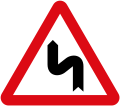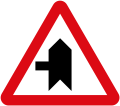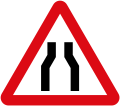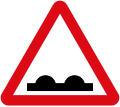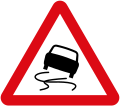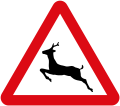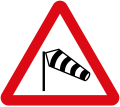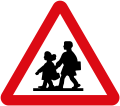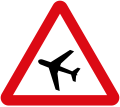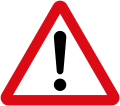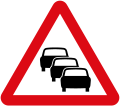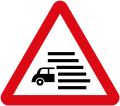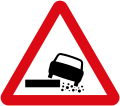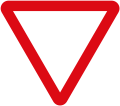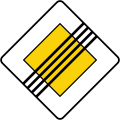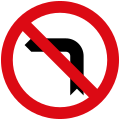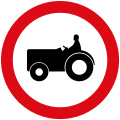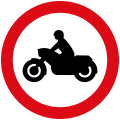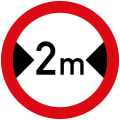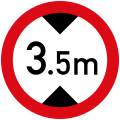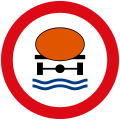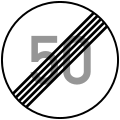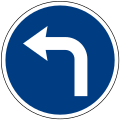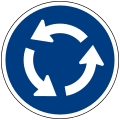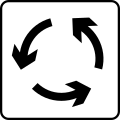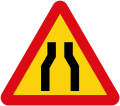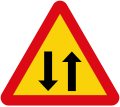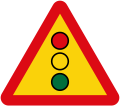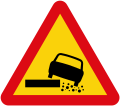
Road signs in Sweden are regulated in Vägmärkesförordningen, VMF (2007:90), and are to be placed 2 metres from the road with the sign 1.6 m from the base for motorized roads. Except for route numbers, there are a maximum of three signs on a pole, with the most important sign at the top. All signs have a reflective layer added on selected parts of the sign as is custom in European countries; most larger signs also have their own illumination.
Road signs in Singapore closely follow those laid down in the traffic sign regulations used in the United Kingdom, although a number of changes over the years have introduced some slight deviations that suit local road conditions. Road signs in Singapore conform to the local Highway Code under the authority of the Singapore Traffic Police.

Road signs in Norway are regulated by the Norwegian Public Roads Administration, Statens vegvesen.

Road signs in Italy conform to the general pattern of those used in most other European countries, with the notable exception that the background of motorway (autostrada) signs is green and those for 'normal' roads is blue. They are regulated by the Codice della Strada and by the Regolamento di Attuazione del Codice della Strada in conformity with the Vienna Convention on Road Signs and Signals.

Road signs in Israel are regulated by the Ministry of Transportation in the Division of Transportation Planning, most recently set forth in June 2011.

Road signs in Greece are regulated by the Ministry of Transport and the Hellenic Traffic Police, according to the Greek Highway Code.

Road signs in the Czech Republic are regulated by the Ministry of Transport and the police. The signs are nearly the same as the European norm, but with small changes. The law governing the road signs is Decree number 30/2001 Sb., many times amended, and replaced by decree 294/2015 Sb., in force since 1 January 2016.
Road signs in Austria are regulated in Straßenverkehrsordnung (StVO).
A wide variety of road signs are displayed in the People's Republic of China.
Road signs in Brunei closely follow the traffic sign regulations used in Singapore as well as the United Kingdom to a lesser extent. A number of changes have also been introduced over the years to suit local road conditions. There are also some differences in the typefaces used, although DIN 1451 remains widely used.
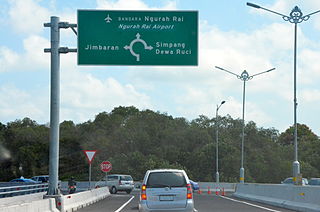
Road signs in Indonesia are standardized road signs similar to those used in other nations but with certain distinctions. As a former Dutch colony, until the 1970s road signs in Indonesia closely followed The Netherlands rules on road signs. Nowadays, Indonesian road sign design are a mix of European, US MUTCD, Australia, New Zealand and Japanese road sign features. According to the 2014 Minister of Transport's Regulation No. 13 concerning Traffic Signs, the official typeface for road signs in Indonesia is Clearview. Indonesia formerly used FHWA Series fonts as the designated typeface though the rules are not being implemented properly.

Road signs in Estonia ensure that transport vehicles move safely and orderly, as well as to inform the participants of traffic built-in graphic icons. These icons are governed by the Vienna Convention on Road Traffic and Vienna Convention on Road Signs and Signals. The system is covered in Liiklusmärkide ja teemärgiste tähendused ning nõuded fooridele and the standards document EVS 613:2001 Traffic signs.

Bosnia and Herzegovina is a signatory of Vienna Convention on Road Signs and Signals. Therefore, road signs do not differ much from the rest of Europe, such as Croatia, Slovenia, Serbia and North Macedonia. Ministry of Transportation of Bosnia and Herzegovina regulates them. Bosnia and Herzegovina drives on the right as with the rest of Europe, except for Cyprus, Ireland, Malta and the United Kingdom. Bosnian and Herzegovinan road signs have two scripts, Latin and Cyrillic script.

Road signs in France refer to all conventional signals installed on French roads and intended to ensure the safety of road users, either by informing them of the dangers and regulations relating to traffic as well as elements useful for decision-making, or by indicating to them the landmarks and equipment useful for their travel on the national territory. They generally largely follow the general European conventions concerning the use of shape and color to indicate their function. France is a signatory to the Vienna Convention on Road Signs and Signals.
Road signs in Turkey conform to the general pattern of those used in most other European countries and set out in the Vienna Convention on Road Signs and Signals. They are regulated by the Trafik İşaretleri Elkitabi.
Road signs in Armenia are similar to the signs of other post-Soviet states and most European road sign systems. Armenia is a signatory of the Vienna Convention on Road Traffic and the Vienna Convention on Road Signs and Signals. The Ministry of Transport regulates these icons, while the police enforces them. Road signs ensure transport vehicles move safely and orderly, as well as, to inform both pedestrians and motorists of traffic rules.

The road signs, used on the Serbian road network, are regulated by the "Regulation of Traffic Signs", which was last time modified in 2017.

Road signs in Portugal are governed by the "Regulamento de Sinalização do Trânsito" of the Republic of Portugal.
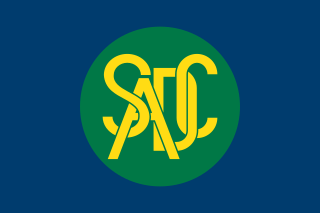
Road signs in South Africa are based on the SADC-Road Traffic Sign Manual, a document designed to harmonise traffic signs in member states of the Southern Africa Development Community. Most of these signs were in the preceding South African RTSM.
Road signs in Angola are heavily modelled on road signs in Portugal, since Angola is a former Portuguese colony. They are regulated in Código de Estrada and conform to the Vienna Convention on Road Signs and Signals.
![]() Freeways
Freeways![]() Roads and Expressways
Roads and Expressways![]() or
or ![]() Temporary signs such as detours and construction sites
Temporary signs such as detours and construction sites



